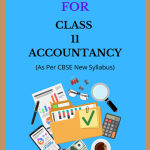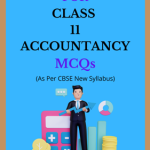NCERT Class 11 Accountancy MCQ Chapter 4 Recording of Transaction-II Solutions, AHSEC Class 11 Accountancy Multiple Choice Question Answer to each chapter is provided in the list so that you can easily browse throughout different chapters NCERT Class 11 Accountancy MCQ Chapter 4 Recording of Transaction-II Question Answer and select needs one.
NCERT Class 11 Accountancy MCQ Chapter 4 Recording of Transaction-II
Also, you can read the AHSEC book online in these sections NCERT Class 11 Accountancy Multiple Choice Solutions by Expert Teachers as per AHSEC (CBSE) Book guidelines. AHSEC Class 11 Accountancy MCQ Solutions. These solutions are part of AHSEC All Subject Solutions. Here we have given HS 1st Year Accountancy Objective Type Question Answer for All Subjects, You can practice these here.
Recording of Transaction-II
Chapter: 4
| PART – Ⅰ |
MULTIPLE CHOICE QUESTION ANSWER
1. What is the primary function of a Journal in accounting?
(i) To record cash receipts and payments.
(ii) To maintain petty expenses.
(iii) To record all transactions as the basic book of original entry.
(iv) To summarise the financial position of a business.
Ans: (iii) To record all transactions as the basic book of original entry.
2. A cheque on which two parallel lines are drawn in the left top corner is called –
(i) Bearer cheque.
(ii) Traveller’s cheque.
(iii) Account payee cheque.
(iv) None of these.
Ans: (iii) Account payee cheque.
3. What is a Cash Book primarily used for?
(i) Recording only credit transactions.
(ii) Recording cash receipts and cash payments.
(iii) Listing assets and liabilities.
(iv) Summarising financial statements.
Ans: (ii) Recording cash receipts and cash payments.
4. Which account is debited when a business incurs a utility expense of ₹1,500?
(i) Cash Account.
(ii) Utilities Expense.
(iii) Accounts Payable.
(iv) Revenue.
Ans: (ii) Utilities Expense.
5. What is the main purpose of a Single Column Cash Book?
(i) To record credit transactions.
(ii) To track financial statements.
(iii) To record all cash transactions of a business.
(iv) To maintain inventory levels.
Ans: (iii) To record all cash transactions of a business.
6. What is the effect on the Cash Account when a company purchases supplies for Rs.1,200?
(i) Debit Rs.1,200
(ii) Credit Rs.1,200
(iii) No effect
(iv) Debit Rs.1,200 and Credit Supplies Account Rs.1,200
Ans: (ii) Credit Rs.1,200
7. What is a “pay-in-slip” used for?
(i) Withdrawing money from a bank account.
(ii) Depositing cash/cheques into a bank account.
(iii) Charging interest on a bank account.
(iv) Calculating account balances.
Ans: (ii) Depositing cash/cheques into a bank account.
8. Income tax is treated as-
(i) Business Expense.
(ii) Direct Expense.
(iii) Personal Expense.
(iv) Indirect Expense.
Ans: (i) Business Expense.
9. What indicates an overdraft in the bank column of a cash book?
(i) A debit balance.
(ii) A credit balance.
(iii) No balance.
(iv) A double entry.
Ans: (ii) A credit balance.
10. Who prepares a debit note-
(i) Seller.
(ii) Purchaser.
(iii) Cashier.
(iv) None of these.
Ans: (ii) Purchaser.
11. _______ is not a subsidiary book.
(i) Purchase book.
(ii) Purchases return book.
(iii) Sales book.
(iv) Ledger.
Ans: (iv) Ledger.
12. Return of goods by a customer is recorded in-
(i) Purchase book.
(ii) Sales book.
(iii) Sales return book.
(iv) Purchase return book.
Ans: (iii) Sales return book.
13. What are total number of subsidiary books available to record financial transactions?
(i) 7
(ii) 9
(iii) 16
(iv) 12
Ans: (i) 7
14. A ledger is called a book of____
(i) Primary entry.
(ii) Final entry.
(iii) None of the options.
(iv) Secondary entry.
Ans: (ii) Final entry.
15. The balance in Petty Cash Book is______
(i) A liability.
(ii) A profit.
(iii) An expense.
(iv) An asset.
Ans : (iv) An asset.

Hi! my Name is Parimal Roy. I have completed my Bachelor’s degree in Philosophy (B.A.) from Silapathar General College. Currently, I am working as an HR Manager at Dev Library. It is a website that provides study materials for students from Class 3 to 12, including SCERT and NCERT notes. It also offers resources for BA, B.Com, B.Sc, and Computer Science, along with postgraduate notes. Besides study materials, the website has novels, eBooks, health and finance articles, biographies, quotes, and more.





